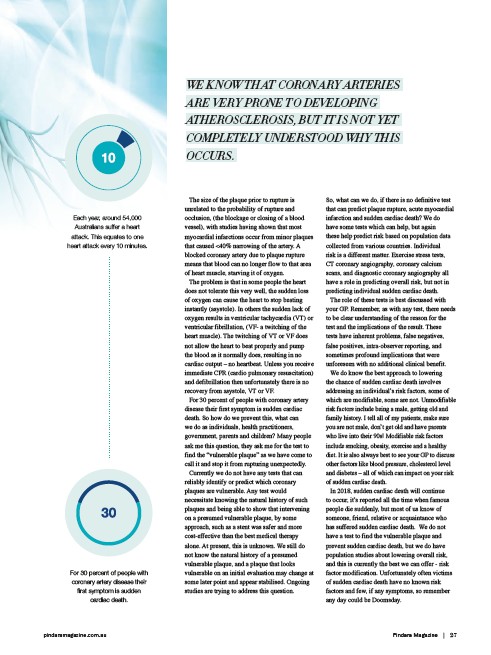
WE KNOW THAT CORONARY ARTERIES
ARE VERY PRONE TO DEVELOPING
ATHEROSCLEROSIS, BUT IT IS NOT YET
COMPLETELY UNDERSTOOD WHY THIS
OCCURS.
The size of the plaque prior to rupture is
unrelated to the probability of rupture and
occlusion, (the blockage or closing of a blood
vessel), with studies having shown that most
myocardial infarctions occur from minor plaques
that caused <40% narrowing of the artery. A
blocked coronary artery due to plaque rupture
means that blood can no longer flow to that area
of heart muscle, starving it of oxygen.
The problem is that in some people the heart
does not tolerate this very well, the sudden loss
of oxygen can cause the heart to stop beating
instantly (asystole). In others the sudden lack of
oxygen results in ventricular tachycardia (VT) or
ventricular fibrillation, (VF- a twitching of the
heart muscle). The twitching of VT or VF does
not allow the heart to beat properly and pump
the blood as it normally does, resulting in no
cardiac output – no heartbeat. Unless you receive
immediate CPR (cardio pulmonary resuscitation)
and defibrillation then unfortunately there is no
recovery from asystole, VT or VF.
For 30 percent of people with coronary artery
disease their first symptom is sudden cardiac
death. So how do we prevent this, what can
we do as individuals, health practitioners,
government, parents and children? Many people
ask me this question, they ask me for the test to
find the “vulnerable plaque” as we have come to
call it and stop it from rupturing unexpectedly.
Currently we do not have any tests that can
reliably identify or predict which coronary
plaques are vulnerable. Any test would
necessitate knowing the natural history of such
plaques and being able to show that intervening
on a presumed vulnerable plaque, by some
approach, such as a stent was safer and more
cost-effective than the best medical therapy
alone. At present, this is unknown. We still do
not know the natural history of a presumed
vulnerable plaque, and a plaque that looks
vulnerable on an initial evaluation may change at
some later point and appear stabilised. Ongoing
studies are trying to address this question.
So, what can we do, if there is no definitive test
that can predict plaque rupture, acute myocardial
infarction and sudden cardiac death? We do
have some tests which can help, but again
these help predict risk based on population data
collected from various countries. Individual
risk is a different matter. Exercise stress tests,
CT coronary angiography, coronary calcium
scans, and diagnostic coronary angiography all
have a role in predicting overall risk, but not in
predicting individual sudden cardiac death.
The role of these tests is best discussed with
your GP. Remember, as with any test, there needs
to be clear understanding of the reason for the
test and the implications of the result. These
tests have inherent problems, false negatives,
false positives, intra-observer reporting, and
sometimes profound implications that were
unforeseen with no additional clinical benefit.
We do know the best approach to lowering
the chance of sudden cardiac death involves
addressing an individual’s risk factors, some of
which are modifiable, some are not. Unmodifiable
risk factors include being a male, getting old and
family history. I tell all of my patients, make sure
you are not male, don’t get old and have parents
who live into their 90s! Modifiable risk factors
include smoking, obesity, exercise and a healthy
diet. It is also always best to see your GP to discuss
other factors like blood pressure, cholesterol level
and diabetes – all of which can impact on your risk
of sudden cardiac death.
In 2018, sudden cardiac death will continue
to occur, it’s reported all the time when famous
people die suddenly, but most of us know of
someone, friend, relative or acquaintance who
has suffered sudden cardiac death. We do not
have a test to find the vulnerable plaque and
prevent sudden cardiac death, but we do have
population studies about lowering overall risk,
and this is currently the best we can offer - risk
factor modification. Unfortunately often victims
of sudden cardiac death have no known risk
factors and few, if any symptoms, so remember
any day could be Doomsday.
Each year, around 54,000
Australians suffer a heart
attack. This equates to one
heart attack every 10 minutes.
For 30 percent of people with
coronary artery disease their
first symptom is sudden
cardiac death.
pindaramagazine.com.au Pindara Magazine | 27